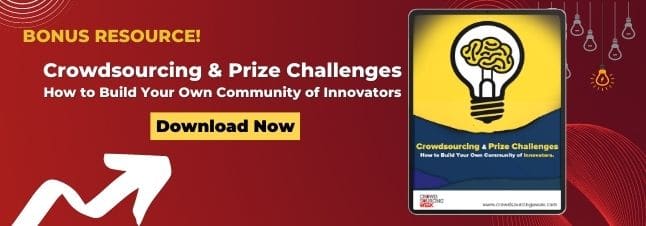This is the third part in our three-part blog series on prize competitions. In Part 1 we shared the power of prize competitions. Part 2 helped you understand what makes a successful prize competition. Now, we will give you some insight on how to choose the appropriate crowd to compete for your prize competition. To begin this process you have to first ask yourself “which type of crowd do you want to help you?” Where are you going to go fishing?
An important element to note when creating an open innovation prize challenge is that you can run either an internal or an external one. Some people remain concerned that using external prize challenges to generate solutions through open innovation techniques has to involve giving out confidential information. Though in reality you can control what information you share with whom, and you can control who competes for your prize competition.
For example, if you are working on a proprietary product and you do not want to share your data/information widely, you can bring in a pre-selected, curated crowd of individuals to compete. You can have them all sign NDAs and protect yourself as if you were working with one of your standard partners through a grant or contract.
Having dealt with this distracting issue, how you decide on which crowd to use (e.g. your internal crowd, an open external crowd, or a curated external crowd) is based on what it is you are looking to accomplish. Think about who can help you accomplish your goals and how would you incentivize them? What sort of people are they; what are they likely to be also doing; what motivates them most effectively – money, accolade, peer group prestige, the prospect of a job?
Internal versus External Challenges
Internal challenges are great for breaking down silos, fostering collaboration, building a community with an organization, and getting new ideas in from other departments. And you do not need to offer a large prize purse. We have seen many internal prize challenges where the motivation to help the organization and be recognized for that contribution is often enough.
Let’s use an example. A high-end consumer products company created a new line. They spent thousands of dollars on outside marketing agencies to develop a name for it. But none of those names resonated with the focus groups or their test markets. They were at a loss and running out of time to get the new product to market. They were keeping the product under wraps and did not want the outside world to know about it right away, so they decided to undertake an internal naming challenge.
They opened up the naming challenge to the whole organization. The prize was just the product itself (worth about $800) and the winning employee’s name in the company newsletter. They had hundreds of submissions. The winning name came from someone in the engineering department – someone with no marketing background. The company trialed the name and decided to go to market with it. This experience had the direct business benefit of coming up with the name for a new product, but also had the indirect benefits of having people think outside their own departments and working together to come up with ideas.
External challenges, on the other hand, are great for augmenting the efforts of an R&D team by bringing in experience you do not have internally. We’ll give you an example. NextEra energy – one of the world’s leaders in wind energy – hosted a challenge on the HeroX platform in 2018. Even though NextEra was one of the world’s leaders in wind energy, they had an ice problem.
As they explained in the prize competition description, ice occasionally accumulates on their turbine blades and the added weight of the ice can reduce performance and shorten the lifespan of their equipment. They hosted a $100,000 prize challenge to spur innovative ideas on how to manage ice on their assets. They have engineers internally working on this, but would never be able to get all the world’s experts on this specific issue to work for them through traditional methods. However, they were able to tap into many great ideas through their prize competition. They said they “were blown away by the creativity of the all the submissions. Your ideas totally surpassed our expectations.”
So, to close, we will ask you again: where are you stuck in your R&D pipeline or where can you use new and different ideas? A prize competition just might be able to help you! We’d like to hear about your own experiences.





0 Comments